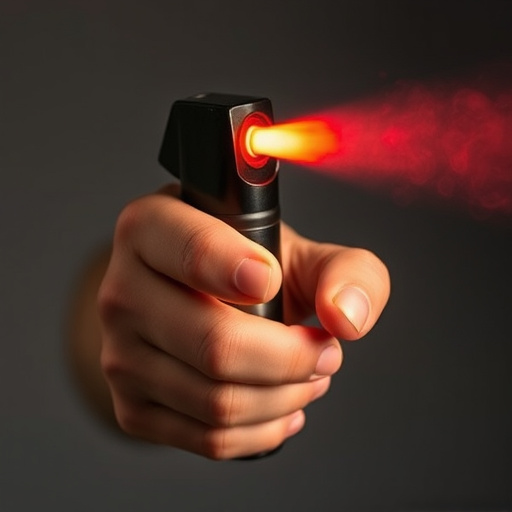Pepper spray, a non-lethal weapon using capsaicin from chili peppers, temporarily incapacitates assailants for 20-60 minutes without causing permanent harm. Its effectiveness depends on factors like capsaicin concentration and environmental conditions. Globally, law enforcement agencies use pepper spray for crowd control, fugitive apprehension, and self-defense, deploying it only as a last resort after implementing safety measures. Despite popular belief, the effects do not always last instantly or longer; typical duration is 20 minutes to an hour, with some formulations offering extended protection.
“Discover the powerful tool that is pepper spray, a staple in law enforcement arsenal. This article delves into the intricate world of this non-lethal weapon, exploring its composition and functionality. We examine its diverse applications in real-world scenarios and dissect the critical protocols officers must follow for safe deployment. Moreover, we clarify misconceptions surrounding its effects’ duration, providing insights that are both comprehensive and eye-opening, particularly on ‘How Long Pepper Spray Effects Last’.”
- Understanding Pepper Spray: Composition and Functionality
- Law Enforcement Use Cases and Protocols
- Safety Measures and Training for Officers
- Duration of Effects: Debunking Common Misconceptions
Understanding Pepper Spray: Composition and Functionality
Pepper spray, a powerful non-lethal weapon, is a chemical agent designed to incapacitate and disorient an assailant while ensuring the safety of law enforcement officers. Its primary active ingredient is capsaicin, a compound derived from chili peppers that binds to nerve endings, causing intense pain and temporary blindness. This unique composition allows pepper spray to neutralize an attacker without causing permanent harm.
The effectiveness of pepper spray can vary depending on several factors, including the concentration of capsaicin, the distance at which it’s deployed, and environmental conditions such as humidity and temperature. Typically, the effects of pepper spray last between 20 to 60 minutes, giving officers crucial time to control a situation or call for backup. This duration ensures that suspects are temporarily disabled, providing law enforcement with a safe opportunity to subdue or apprehend them.
Law Enforcement Use Cases and Protocols
Law enforcement agencies worldwide utilize pepper spray as a non-lethal force option for various scenarios, including crowd control, fugitive apprehension, and self-defense. Its effectiveness lies in its ability to disable or deter individuals temporarily, allowing officers to gain control or subdue suspects. Pepper spray is deployed when other less-lethal tools are inadequate or inappropriate.
When used according to protocol, pepper spray can immobilize a target for several minutes, providing officers with crucial time to secure the scene or arrest a suspect. The duration of its effects varies depending on factors such as the concentration of capsaicin (the active ingredient), weather conditions, and individual sensitivity. On average, how long pepper spray effects last ranges from 20 to 45 minutes, ensuring it remains a valuable tool in law enforcement operations, particularly in high-stress, dynamic situations.
Safety Measures and Training for Officers
Law enforcement officers are required to undergo rigorous training before being authorized to carry and use pepper spray. This training covers safe handling, deployment strategies, and de-escalation techniques. It’s crucial to understand that pepper spray is a powerful tool, designed to temporarily incapacitate individuals, not cause harm. The impact of pepper spray can last for 20-60 minutes, during which time an officer must maintain distance and monitor the subject’s condition. Training also emphasizes the importance of using pepper spray only as a last resort, when other non-lethal force options are ineffective or unsafe.
Safety measures include ensuring proper ventilation at the scene, wearing protective gear such as gloves and goggles, and being aware of potential health risks for individuals with pre-existing conditions. Officers are taught to assess the situation critically, use pepper spray judiciously, and provide immediate first aid or medical assistance if needed. Regular refresher courses are conducted to keep officers updated on best practices, new regulations, and advancements in pepper spray technology.
Duration of Effects: Debunking Common Misconceptions
Pepper spray, a common law enforcement tool, often sparks debate due to misconceptions about its effects and duration. A widely held belief is that the impact is instantaneous and lasts for several minutes, leaving the target helpless. However, this is not entirely accurate. The effects of pepper spray are designed to be disabling but temporary.
In reality, how long pepper spray effects last can vary depending on factors such as concentration, delivery method, and individual sensitivity. Typically, the active ingredient in pepper spray, capsaicin, causes a burning sensation and distress by affecting the body’s nerve endings. The duration of these effects usually ranges from 20 minutes to an hour, with some formulations providing longer-lasting protection. It’s crucial for law enforcement officers to understand that while pepper spray can temporarily incapacitate a suspect, it is not intended to cause permanent harm.
Pepper spray, a powerful law enforcement tool, has been refined over time. Understanding its composition, functionality, and safe application is crucial for both officers and the public. While often misunderstood, research clarifies that pepper spray’s effects last approximately 2-5 minutes, providing a temporary but effective deterrent. Proper training and safety protocols are essential to ensure its responsible use, balancing public safety with minimal harm. By adhering to best practices, law enforcement can continue to leverage this game-changing tool effectively in today’s digital era.
